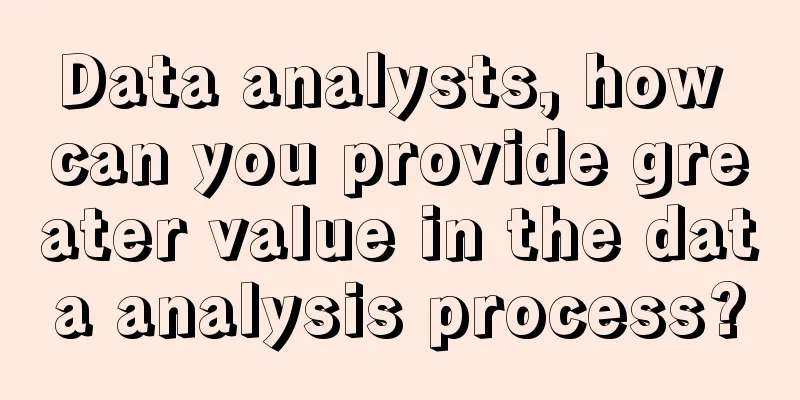Data analysts, how can you provide greater value in the data analysis process?

A friend who works as a data analyst expressed his anxiety to me. He felt that there was no technical content in collecting data every day. He knew he had to do analysis, but he didn't know how to do it. This friend is a microcosm of many people. Many people start with data collection from the first day they join the company , thinking that data collection is all there is to their job. They have never seen what real analysis is like , nor have they participated in business decision-making. They want to jump out but don’t know where to start. They are stuck in the boring and low-quality work of data collection. I have given a lot of advice before, such as doing less data collection and more analysis, etc. Now I think it may be easier to understand from the meaning of the position of data analyst . Today, let’s learn what data analysis is. 01 What is “data analysis”?First of all, it should be noted that what data analysis does is different from what data analysts do. To know what data analysts do, you must first know what data analysis does. Data analysis is a method of decision-making. It is a complete analytical process of summarizing experience and deriving conclusions from historical data. Corresponding to the decision-making method of data analysis are decision-making based on intuition and decision-making based on experience. Sometimes, it is not that the decision made by making a decision ... Here is a story about porcelain so you can understand the difference between the two. For a long time in history, Chinese porcelain was the best in the world . At the end of the Ming Dynasty, only China and its two vassal states, Korea and Vietnam, could make porcelain. Porcelain could bring a lot of silver, so the court had very strict management of porcelain craftsmen. People from other countries could not contact porcelain craftsmen and could not get the production methods. At that time, European porcelain was very expensive, and Europeans really wanted to make their own porcelain. In the 18th century, an alchemist named Böttger began to study porcelain, but Böttger did not know the composition of porcelain clay, so he could only keep trying . Fortunately, he had the basics of alchemy and knew some chemical experimental methods. It took a whole year to fire a pottery with very poor appearance, which was very ugly and unusable. In the third year, he was very lucky to find soil suitable for firing in a certain area of Germany. However, the composition of the soil was not exactly the same as that of Chinese porcelain clay. Porcelain could not be fired directly. Later, Böttger conducted many experiments. Finally, he found that adding a certain proportion of feldspar to the soil could produce white porcelain. During these four years, he conducted 30,000 experiments, and he not only recorded the entire experimental process and results, but also recorded all the tiny differences between each experiment. With these records, Europeans continued to improve porcelain . For example, the French invented enamel porcelain, and the British invented bone china. In the 18th century, enamel porcelain was brought to China by Europeans. Emperor Kangxi liked it very much and asked for a replica. This indicated that China's porcelain manufacturing technology had fallen behind Europe at that time. The development of Chinese and European porcelain in this story is the difference between experience-based decision-making and data-based decision-making. Ancient China made decisions based on experience . The firing methods of porcelain were passed down orally and through years of experience, and the craftsmanship was often lost. Although Chinese porcelain has always been the world leader in history, it did not pay attention to quantitative measurement and had no experimental records, so it did not make any progress for a long time. Europe makes decisions based on data . Although European porcelain started from a lower starting point, it soon surpassed Chinese porcelain because it recorded the composition ratio and process of ceramics. This is the value of data analysis. Business operations, like porcelain production, have many areas that need improvement. If you don't make decisions based on data, you will soon be caught up by others and lose your competitiveness. 02 What does a “data analyst” do?The decision-making process of data analysis will encounter some problems in the process of advancement, such as no data, messy data, difficulty in obtaining data, lack of mathematical statistics knowledge, etc. Therefore, in order to promote this process, data analysts come on the scene. Let's take an example of an Internet company:
The entire decision-making process is data analysis. However, in this data analysis, the operations colleagues are the protagonists and the data analysts are the supporting roles . The entire analysis framework is led by the operations colleagues, and the data analysts are only responsible for collecting data. The data analysts do not know the overall picture, which is a bit like a blind man touching an elephant, who can only see part of it but not the whole. But without a data analyst, this process would be more troublesome. What could have been done in one day could take three days. So the value of the data analyst in this case is to improve the efficiency of data analysis. In general, any work that promotes the completion of the data analysis process can be the work of a data analyst. In order to complete the entire process of data analysis, we generally have to do three things: obtain data, process data, and analyze data. The corresponding work content of these things is:
All of the above jobs are related to data analysts. Some companies divide them into more detailed categories, and data analysts are only responsible for processing and analysis. Some companies are relatively rough, and data analysts have to take on multiple roles and be able to do a little bit of everything. There are different positions but they are all called data analysts. This is one of the reasons why the job requirements for data analysts in the industry are very chaotic. When applying for a job, you should also pay attention to the fact that the job requirements for these data analysts vary greatly. Some require knowledge of Excel and SQL, some require knowledge of Hadoop, some require consulting company experience, etc. If you want to apply for a job in a prepared manner, you must first understand what the job focuses on. 03 What do data analysts usually do?Data analysts are not the glamorous military strategists who go in and out of high-level meeting rooms. Instead, they are a very hard job with a lot of dirty work. The dirty work that is often encountered is: data collection, caliber matching, and bottom-level reconstruction. The three mountains of data analysts are:
Get data : Collecting data is the most common job for most data analysts. Leaders need you to collect data when making decisions, business reports need you to collect data, and you also need to collect data when doing analysis. Sometimes, in order to get a number, you have to sort out the entire underlying data. You spend most of the day and only get one or two numbers. The leader seems to think that you are inefficient and spend half a day to get a number. It is really hard to describe the pain. For caliber: The pain of data retrieval comes not only from the workload, but also from the fact that the calibers are often inconsistent. The data retrieved does not match the report , the business system , the data obtained last time, etc. , which will make people lose their mentality. Sometimes, after working hard for an afternoon, the data retrieved is found to be inconsistent. You have to spend time to check the caliber differences between the two data. If you are wrong, you have to retrieve it again. Sometimes if one piece of data is inconsistent with others, the entire report has to be rewritten. Inconsistent caliber is not a problem unique to startups, it also exists in large companies. There may be multiple versions of the caliber of the number of new users in a company. I think every data analyst’s New Year’s wish must be that all calibers can be aligned. Bottom-level reconstruction: As the business develops, the dimensions and indicators in the underlying data tables often change, which requires underlying reconstruction. The pain of this work is that if the underlying data changes, the corresponding reports must also change , and the templates of weekly and monthly reports must also change . Then the business will feedback some data retrieval requirements for the new data ... The above work accounts for 70 to 80 percent of the time spent on data analysis in daily work, and the work that really creates value is only concentrated in the remaining 20 percent of the time. Therefore, the low sense of value of data analysts mentioned by the friend at the beginning is a very common phenomenon. So how to improve the value? 03 How to improve the value of data analystsThe value of a data analyst depends on the role he plays in the entire data analysis process. Generally speaking, high-value jobs include:
1. Ask good questionsA good question is the most important factor in determining the upper limit of the analysis value. Which of the following questions is more valuable?
The first is the issue of specific implementation , which is related to the work of a specific business colleague. The result of the analysis is the final selection of a set of solutions. The second is a tactical level issue that concerns the work of an operations team, and the outcome of this issue may lead to a change in the focus of the operations team's work. The third is a strategic issue that affects the work of the entire project team. The results of the analysis may lead to changes in the project team's KPIs or even adjustments to the organizational structure. So it is obvious that the third strategic level issues are more valuable. However, few data analysts can directly participate in strategic-level analysis. Analyzing strategic-level problems may be impractical. However, tactical-level problems can still be addressed, and we should try to analyze higher-dimensional problems. 2. TitleDaily analysis often stops at the surface:
These answers are too superficial, and only give superficial reasons. If you give too many such conclusions, the business will only come to you to get numbers in the future, because you can't give them the results they want. The results of the analysis are at several levels:
Give as much how as possible. If you can’t give a number, give why. If it’s all what, then the value is too low. 3. Summarize and analyze routinesThe first two directions are to do deeper data analysis, dig deeper into objects, and provide deeper answers. If you can't provide more value in depth, then you can consider providing value in quantity. This does not mean that you should do more analysis. A person's time is always limited. No matter how hard you work overtime, it is difficult to produce results that are an order of magnitude higher than usual. However, you can summarize some analytical methodologies for similar problems and promote these methodologies to the entire company, or even directly deposit them in the business system. Then more people will adopt such methods, and the efficiency of the entire company will be improved from your output. 4. Provide efficient toolsAnother way to increase the number is to provide efficient tools. This is the easiest to do, but also the hardest kind of work. Every company has some reports, but whether the reports are useful or not is another matter. Most reports only meet some basic data query needs, but the data caliber is often complicated and unclear. The performance structure of the report is also relatively chaotic, and it cannot solve some personalized drill-down or aggregation needs. If you can provide a report or data product with a unified caliber, clear hierarchy, and continuous maintenance, this is also a high-value job. Many large companies will have a dedicated team to maintain a mature reporting system. All changes at the business level will be notified to this team, and then modified based on the report. Over time, this data product has become an indispensable part of the company's workflow. However, not all leaders can see the value of this work. It may happen that when you are there, others don't think this set of reports is important, but when you leave, they realize that they can't do without you. Even if your leader values it very much, you should know that this kind of systematic reporting system is not very impressive in the early stage. Maybe no one will approve of it in the first three months. But when it reaches a certain level, it will produce a qualitative change. So you need a certain amount of patience to do this kind of work. 5. Solve difficult problemsA final way to add value to your work is to solve difficult problems. There are many types of difficult questions.
Difficult work that is required by the business but cannot be done by others but you can is valuable work. summaryData analysis is essential for enterprises and organizations, but data analysts are not necessarily. What we can do is to maximize our value in the data analysis process. If data analysts cannot provide greater value in the data analysis process, then data products + business interpretation can replace most data analysts. The position of data analyst is not standardized. What you can do depends on your overall ability. Knowing what data analysis is can help us understand where we can play a role. If we don't know the problems that data analysts need to solve, we don't know where we can play a role. Combine your own strengths, find the part of the process where you can play the greatest value , and work together to become a high-value data analyst. Author: Jason WeChat public account: Sanyuanfangcha (ID: sanyuanfangcha), focusing on driving business growth with data, good at data analysis and user growth. Likes reading, thinking and creation. |
Recommend
Review of Spring Festival Marketing: Six Major Changes, Anchoring the New Year with a New Atmosphere
What did brands do during the Spring Festival mark...
Illegal content on Douyin can be modified!
The Douyin platform recently launched a new featur...
Is it profitable to open a store on Lazada? How to increase profits?
Nowadays, no matter which platform you join to do ...
Don’t know what type of notes to write on Xiaohongshu? Read this article quickly!
Do you have no idea what type of notes to write wh...
Internet celebrity ice cream for winter
Do you remember the "Ice Cream Assassin"...
The overly strong product placement in "Xi Ren" caused offence. Is it the brand's fault?
The latest episode of "Xiren" is on the ...
Big changes to the entertainment live streaming policy on video accounts? The commission is reduced, and the tasks are difficult to complete...
The video account entertainment live broadcast pol...
Love among middle-aged people and the hidden thread of brands
This article uses Xiaodu Smart's recently laun...
How is the creative profit-sharing plan divided?
Recently, the "creative profit sharing plan&q...
What products are suitable for selling on the Wish platform? What should I pay attention to when uploading products?
When we choose a platform to sell things, we need ...
The industry return rate is 80%? What else can practitioners who refuse to accept their fate do?
Faced with the challenge of high return rates in t...
What is suitable for selling in Singapore as a cross-border e-commerce platform? How to choose products?
The first thing to do when opening a store on a cr...
6 steps to teach you how to activate a "dead" group in your private domain!
This article analyzes in detail how to reactivate ...
Can I open an Amazon store without a trademark? Can I launch a product without a trademark?
There are many brand merchants on Amazon. After al...
What problems will be encountered during cross-border logistics and transportation? How to solve them?
Cross-border logistics is a very critical part of ...









